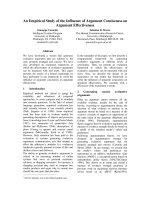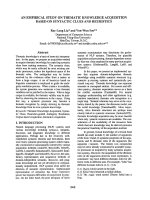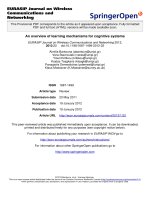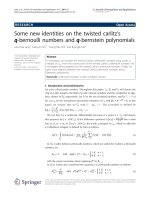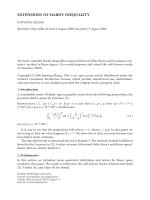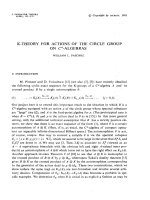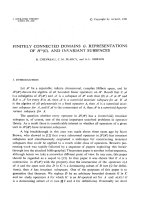Báo cáo toán học: "An addition theorem on the cyclic group Zpαqβ" pptx
Bạn đang xem bản rút gọn của tài liệu. Xem và tải ngay bản đầy đủ của tài liệu tại đây (63.31 KB, 4 trang )
An addition theorem on the cyclic group Z
p
α
q
β
Hui-Qin Cao
Department of Applied Mathematics
Nanjing Audit University, Nanjing 210029, China
Submitted: May 22, 2005; Accepted: Apr 30, 2006; Published: May 12, 2006
Mathematics Subject Classifications: 11B75, 20K99
Abstract
Let n>1 be a positive integer and p be the smallest prime divisor of n.Let
S be a sequence of elements from Z
n
= Z/nZ of length n + k where k ≥
n
p
− 1. If
every element of Z
n
appears in S at most k times, we prove that there must be a
subsequence of S of length n whose sum is zero when n has only two distinct prime
divisors.
1 Introduction
Let G be an additive abelian group and S = {a
i
}
m
i=1
be a sequence of elements from G.
Denote σ(S)=
m
i=1
a
i
.WesayS is zero-sum if σ(S) = 0. For each integer 1 ≤ r ≤ m,
we denote
r
S = {a
i
1
+ a
i
2
+ ···+ a
i
r
:1≤ i
1
<i
2
< ···<i
r
≤ m}.
Let h(S) denote the maximal multiplicity of the terms of S.
In 1961, Erd˝os-Ginzburg-Ziv [1] proved the following theorem.
EGZ Theorem If S is a sequence of elements from Z
n
of length 2n− 1, then 0 ∈
n
S.
The inverse problem to EGZ Theorem is how to describe the structure of a sequence
S in Z
n
with 0 ∈
n
S. Recently W. D. Gao [2] made a conjecture as follows and proved
it for n = p
l
for any prime p and any integer l>1.
Conjecture Let n>1, k be positive integers and p be the smallest prime divisor of n.
Let S be a sequence of elements from Z
n
of length n + k with k ≥
n
p
− 1.If0 ∈
n
S
then h(S) >k.
the electronic journal of combinatorics 13 (2006), #N9 1
In this paper we shall prove the Conjecture for n which has only two distinct prime
divisors.
Theorem 1 The above Conjecture is true for n = p
α
q
β
where p, q are distinct primes
and α, β are positive integers.
2 Proof of Theorem 1
For any subset A of an abelian group G let H(A) denote the maximal subgroup of G such
that A + H(A)=A. What we state below is a classical theorem of Kneser [3].
Kneser’s Theorem Let G be a finite abelian group. Let A
1
,A
2
, ,A
n
be nonempty
subsets of G. Then
|A
1
+ A
2
+ ···+ A
n
|≥
n
i=1
|A
i
+ H|−(n − 1)|H|,
where H = H(A
1
+ A
2
+ ···+ A
n
).
Lemma 1 Let k ≥ 2,n = p
α
1
1
p
α
2
2
be integers where p
1
,p
2
are distinct primes and α
1
,α
2
are positive integers. Let S be a sequence of elements from Z
n
= Z/nZ of length n + k.
If h(S) ≤ k then H(
k
S) = {0}.
Proof Suppose that H(
k
S)={0}.LetN
i
be the subgroup of Z
n
with |N
i
| = p
i
for i =1, 2. Then
k
S + N
i
⊆
k
S for i =1, 2. And so there exist subsequences
{a
(i)
j
}
k
j=1
(i =1, 2) of S such that
k
j=1
a
(i)
j
+ N
i
⊆
k
S, i =1, 2.
We can assume that a
(1)
j
= a
(2)
j
for 1 ≤ j ≤ l and a
(1)
j
= a
(2)
r
for l<j,r≤ k.Then
{a
(1)
1
,a
(1)
2
, ··· ,a
(1)
l
,a
(1)
l+1
, ··· ,a
(1)
k
,a
(2)
l+1
, ··· ,a
(2)
k
}
is a subsequence of S. Now we distribute the terms of S into k subsets A
1
,A
2
, ,A
k
.
At first, we put a
(1)
j
into A
j
for 1 ≤ j ≤ l and a
(1)
j
,a
(2)
j
into A
j
for l<j≤ k. Then the
other terms of S are put into A
1
,A
2
, ··· ,A
k
such that each A
i
does not include identical
terms. Since h(S) ≤ k, we can do it. Therefore
k
j=1
a
(1)
j
∈ A
1
+ A
2
+ ···+ A
k
,
the electronic journal of combinatorics 13 (2006), #N9 2
and
k
j=1
a
(2)
j
=
l
j=1
a
(1)
j
+
k
j=l+1
a
(2)
j
∈ A
1
+ A
2
+ ···+ A
k
.
As A
1
+ A
2
+ ···+ A
k
⊆
k
S,wehave
k
j=1
a
(i)
j
+ N
i
⊆ A
1
+ A
2
+ ···+ A
k
,i=1, 2.
It follows that
N
i
⊆ H(A
1
+ A
2
+ ···+ A
k
),i=1, 2.
Since every nontrivial subgroup of Z
n
contains either N
1
or N
2
,wemusthaveH(A
1
+
A
2
+ ···+ A
k
)={0}. As a result, Kneser’s Theorem implies
|A
1
+ A
2
+ ···+ A
k
|≥
k
j=1
|A
j
|−(k − 1) = n +1,
contradicting A
1
+ A
2
+ ···+ A
k
⊆ Z
n
.
Now the proof is complete.
Lemma 2 (Gao, [2]) Let G be a cyclic group of order n.LetS be a sequence of elements
from G of length n + k where k ≥
n
p
− 1 and p is the smallest prime divisor of n. Then
n
S
H = ∅
for any nontrivial subgroup H of G.
Proof For any nontrivial subgroup H of G,letϕ : G → G/H be the natural homomor-
phism. Then ϕ(S) is a sequence of elements from G/H of length n + k.Since|H|≥p,
n + k ≥ n +
n
p
− 1 ≥|H||G/H| + |G/H|−1,
using EGZ Theorem repeatedly, we can find |H| disjoint zero-sum subsequences of ϕ(S),
each of which has length |G/H|. Thus we find a subsequence of S with length |H||G/H| =
n, whose sum is in H, i.e.,
n
S ∩ H = ∅. We are done.
ProofofTheorem1 Suppose that h(S) ≤ k. By Lemma 1, H = H(
k
S) = {0}.
Thus Lemma 2 implies that
n
S ∩ H = ∅. Therefore we have a subsequence {a
i
}
k
i=1
of
S such that σ(S) −
k
i=1
a
i
∈ H.Andso
σ(S) ∈
k
i=1
a
i
+ H ⊆
k
S + H =
k
S.
It follows that 0 ∈
n
S. This ends the proof.
Acknowledgment. I would like to thank W. D. Gao for his report in which he introduced
his conjecture.
the electronic journal of combinatorics 13 (2006), #N9 3
References
[1] P. Erd˝os, A. Ginzburg and A. Ziv, Theorem in the additive number theory, Bull. Res.
Council Israel, 10 F(1961), 41-43.
[2] W. D. Gao, R. Thangadurai and J. Zhuang, Addition theorems on the cyclic group
Z
p
n
, preprint.
[3] M. Kneser, Ein satz ¨uber abelsche gruppen mit anwendungen auf die geometrie der
zahlen, Math. Z., 61(1955), 429-434.
the electronic journal of combinatorics 13 (2006), #N9 4
